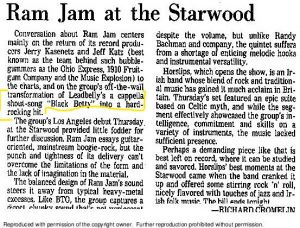Ram Jam’s “Black Betty” is a staple of classic rock radio, instantly recognizable and frequently featured in movies, TV shows, and commercials. Its driving rhythm and catchy chorus make it an undeniable earworm. Many appreciate the song for its raw energy and infectious groove, characterized by rhythmic shifts and a compelling melody.
Ram Jam – Black Betty (Official Audio)
However, the story behind “Black Betty,” and its deeper roots in African American musical tradition, often goes unexamined. While Ram Jam credited blues and folk icon Lead Belly as the originator of their hit, as noted in a review by Richard Cromelin of a Ram Jam concert in the Los Angeles Times in 1977, the lineage is richer and more complex.

Lead Belly’s rendition is indeed a crucial piece of the puzzle, offering a folk interpretation of “Black Betty.”
[Listen to Leadbelly’s version of Black Betty]
Yet, attributing the song solely to Lead Belly oversimplifies its history. Music scholars, like Henry Edward Krehbiel, argue that true folk songs emerge from collective experience, not a single author. The origins of “Black Betty” are indeed murky, as is the meaning of the term itself – was “Black Betty” a thing or a person? Historical research suggests “Black Betty” could have been slang as far back as the early 1800s, possibly referring to a musket or a bottle of whiskey. These interpretations are certainly plausible within the context of the song’s lyrics.
One particularly insightful source comes from the renowned folklorists John and Alan Lomax. In their extensive documentation of Southern chain gang songs, the Lomaxes recorded a version of “Black Betty” sung by a convict at Darrington Farm in Texas. Their understanding of “Black Betty” offers a starkly different perspective:
“Black Betty is not another Frankie, nor yet a two-timing woman that a man can moan his blues about. She is the whip that was and is used in some Southern prisons… where […] whipping has been practically discontinued…”
Given that Lead Belly himself spent time in Texas prisons and was exposed to chain gang labor, it’s highly probable he learned “Black Betty,” and many other songs, within that harsh environment. This connection opens a pathway to tracing the song’s roots even deeper, potentially into the songs of enslaved African Americans.
Thus, the journey of “Black Betty Bam A Lam Song” reveals a fascinating transmission of musical heritage, from the likely origins in African American slave songs and work songs to its adoption and popularization by white artists like Ram Jam. While Ram Jam acknowledged Lead Belly’s recording, recognizing the deeper, often painful, history embedded within “Black Betty” is essential. The song serves as a powerful reminder of the enduring influence of Black folk music on American popular culture, an influence that continues to resonate today.
Notes
[1] Cromelin, Richard. “Ram Jam at the Starwood.” Los Angeles Times (1923-1995), Nov 12, 1977. 1, https://search.proquest.com/docview/158397115?accountid=351.
[2] Krehbiel, Henry Edward. “Songs of the American Slaves” in Afro-American Folksongs: A Study in Racial and National Music (New York: Frederick Ungar Publishing Co., 1914), 11-28.
[3] Lomax, John A., Lomax, Alan. “Songs from Southern Chain Gangs” in American Ballads & Folk Songs (New York: Macmillan Co., 1935), 57-86.
